The Ethnic Studies Department is Sacramento State’s only department that focuses on race, class, and ethnicity in its curriculum, research, and community projects. Even though it may seem like a solid fixture on campus now, celebrating its 50th anniversary in 2020, and ethnic studies is now a requirement for all CSU students, the fight for this department was actually filled with controversy, activism, and even contributed to the censure and resignation of a Sac State President! Scroll through the facts below to learn more about the revolutionary creation of Sac State’s Ethnic Studies Department during the turbulent 60s!
Fact #1: The Sac State Ethnic Studies Department was founded because of the tumultuous and violent San Francisco State Third World Liberation Protests of 1968
- The longest student strike in history, which lasted five months, was led by the Black Student Union and a coalition of marginalized students called the Third World Liberation Front. They sought more minority representation in the student body, faculty hiring, and course curriculum, as well as a guarantee of freedom of speech on campus.
- The protests began on when graduate student and student teacher George Murray, a member of the Black Panther’s, was fired on November 1, 1968 for incendiary remarks he made while advocating for black Civil Rights.
- These protests were full of violence and police brutality against students.
- The protests began on when graduate student and student teacher George Murray, a member of the Black Panther’s, was fired on November 1, 1968 for incendiary remarks he made while advocating for black Civil Rights.
- The strike ended in March of 1969 and led to the creation of the College of Ethnic Studies, which would focus on teaching the history and cultures of ethnic minorities.
- This was the first program focusing on ethnic studies in the history of the United States.
Fact #2: Student activists at Sac State immediatley organized their own protests in support of the grievances of the SFSU strikers
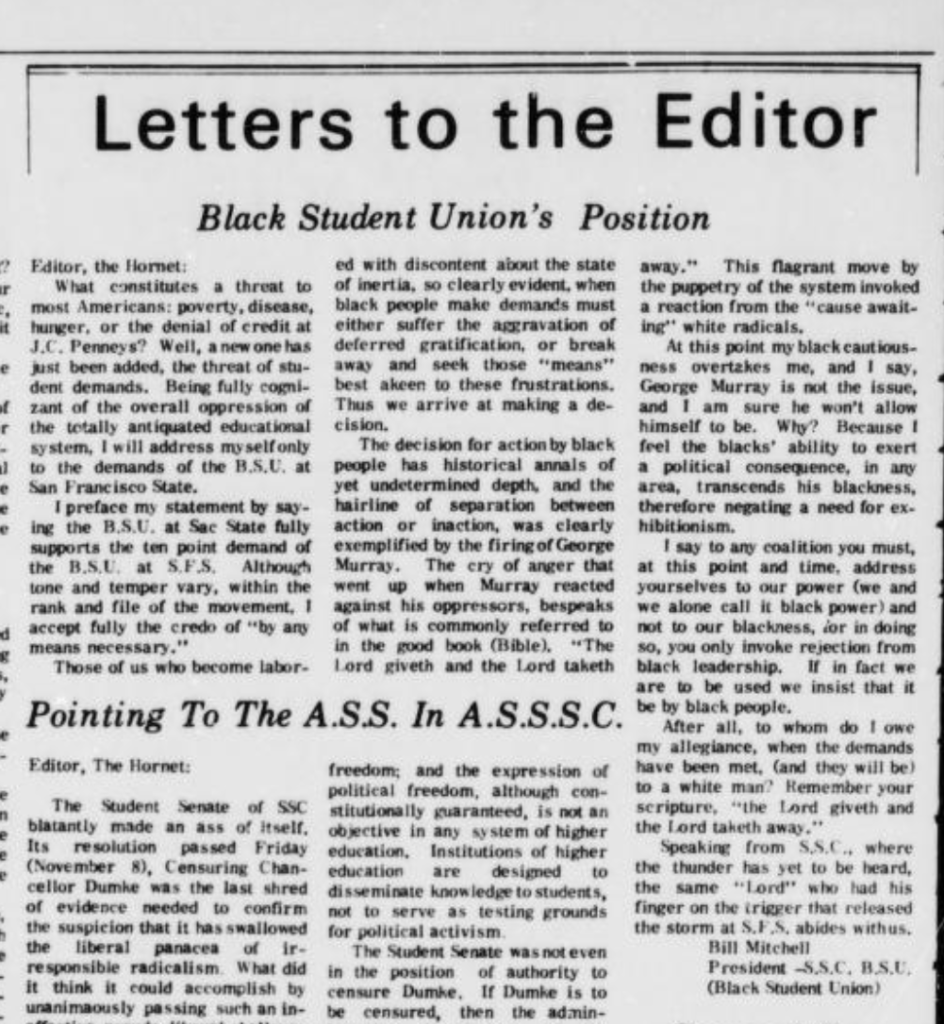
- On November 19, 1968 Sac State students staged a “teach-in” at the CSU Chancellor’s Office downtown, and stopped all work in the office by educating the staff on the issues that SFSU students, and minority students at Sac State too, faced.
- On this day the CSU Trustees and the Chancellor were meeting in Los Angeles to discuss the SFSU protests, so the Sac State teach-in was done to get their attention and distract them from cracking down on the SFSU protests.
- The same day the Sac State BSU President aligns the campus group fully with the SFSU BSU’s demands in the Letter to the Editor in The State Hornet.
- On November 24, 1968 a “hush-up” was organized on campus, where students and faculty were asked to remain silent on campus and only communicate through writing in protest of recent perceived infringements on academic freedom and unfair budget cuts.
- There was wide campus engagement, with moderate students, the BSU, and the Young People’s Socialist League (YPSL) all participating.
- However, not all students and faculty support these student activists and tensions between the pro-strikers and anti-strikers grows over the weeks following the SFSU strike.
Fact #3: Sac State students and faculty teamed up to convince administration to create the department
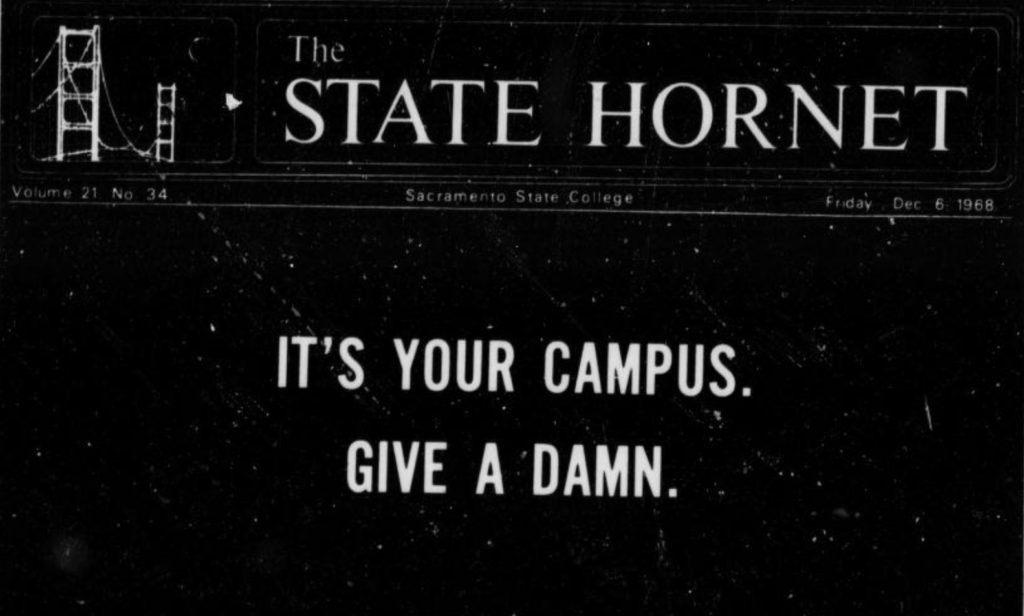
- As protests spread at college campuses across the state, and the fear of possible violent unrest on campus grew, President Robert Johns created a nine student/faculty commission to create a dialogue between their group and administration to prevent violence like at SFSU.
- However, the commission instead made 3 demands of administration
- 1. A commitment from President Johns to defend academic freedom on campus
- 2. A promotion of student self-determination on campus
- 3. The creation of an Ethnic Studies Department
- However, the commission instead made 3 demands of administration
- On December 6th the commission holds a campus-wide Convocation, or essentially a town hall meeting, where student and faculty supporters gained widespread campus support from unsure students by explaining minority students’ struggles gaining representation and respect on campus.
- An example of this was reported in The State Hornet, where BSU member Dick Reynolds interrupted arguing liberal and conservative students and asked “Will you help me? That’s all I want to know, will you help me?” A conservative student immediatley replied “Yes.” This instance of understanding despite conflict showed support and empathy growing for ethnic minority students.
Fact #4: Sac State President Robert Johns caused outrage when he stormed out of a meeting between students and administration over the creation of the department, and he soon resigned partly because of the controversy
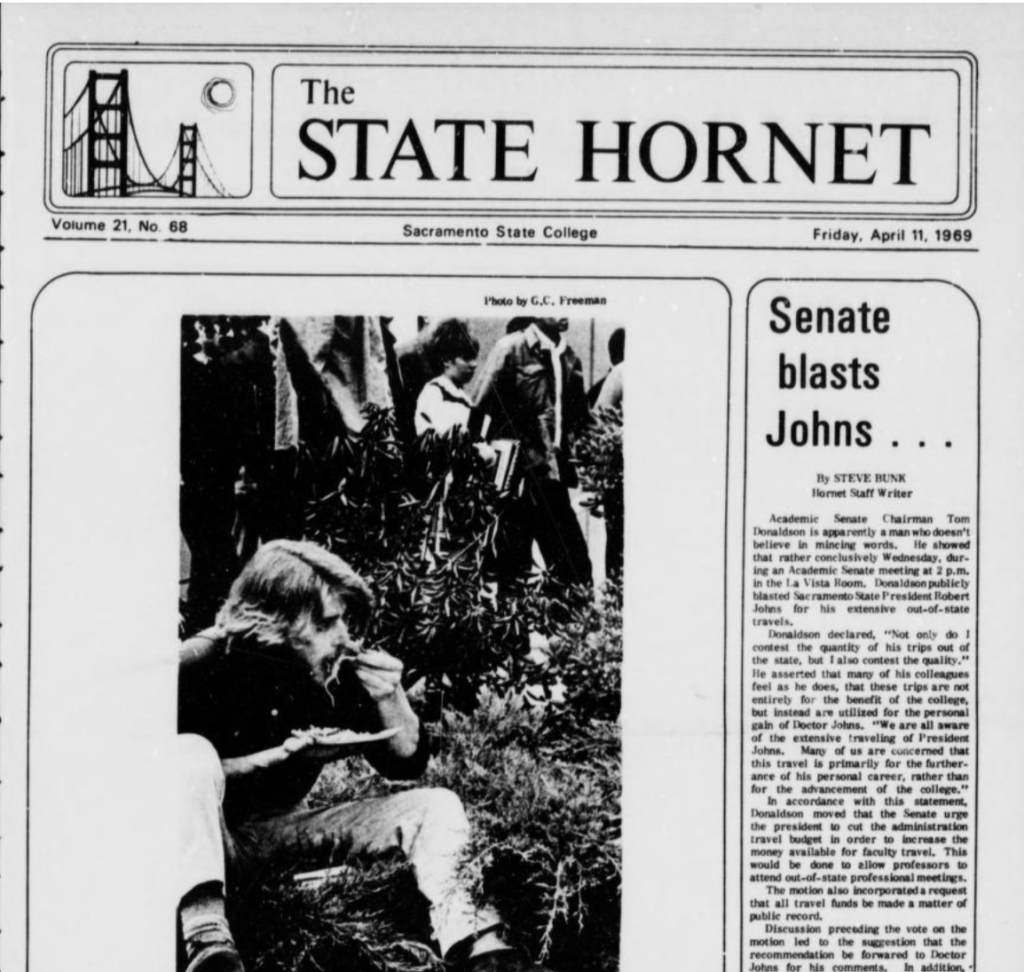
- In the months following the Convocation student activist groups, such as the BSU, the Mexican American Youth Association (MAYA), and Asian-American student activists meet many times with administration and Vice President and Otto Butz to negotiate for the Ethnic Studies Department.
- After many months of not attending any meetings President Robert Johns attended one on April 4, 1969 with Vice President Butz and minority students and became outraged over the concessions Butz had made to the students, especially promising ten new dedicated ethnic studies faculty positions.
- He stormed out of the meeting without finishing what would have been the last negotiations before the department was officially organized, and this outraged students and faculty across campus who had been working for months to get the plan for the new department through
- 30 minutes later President Johns issued an apology, outrage persisted and students from the BSU, MAYA, Asian-American student activists, and the Young Republicans held a press conference and to demand Johns accept a new proposal of 20 faculty positions.
- Students also notably said that if violence came to campus that it would be the “direct result of the failure of established procedures to provide answers.”
- On April 9th the Academic Senate condemned Johns for his exorbitant travel spending and his disrespect to student and faculty over the creation of the Ethnic Studies Department, and he was formally censured. Soon after this, he resigned.
Fact #5: Sac State’s Ethnic Studies Department was established in 1969-1970 school year
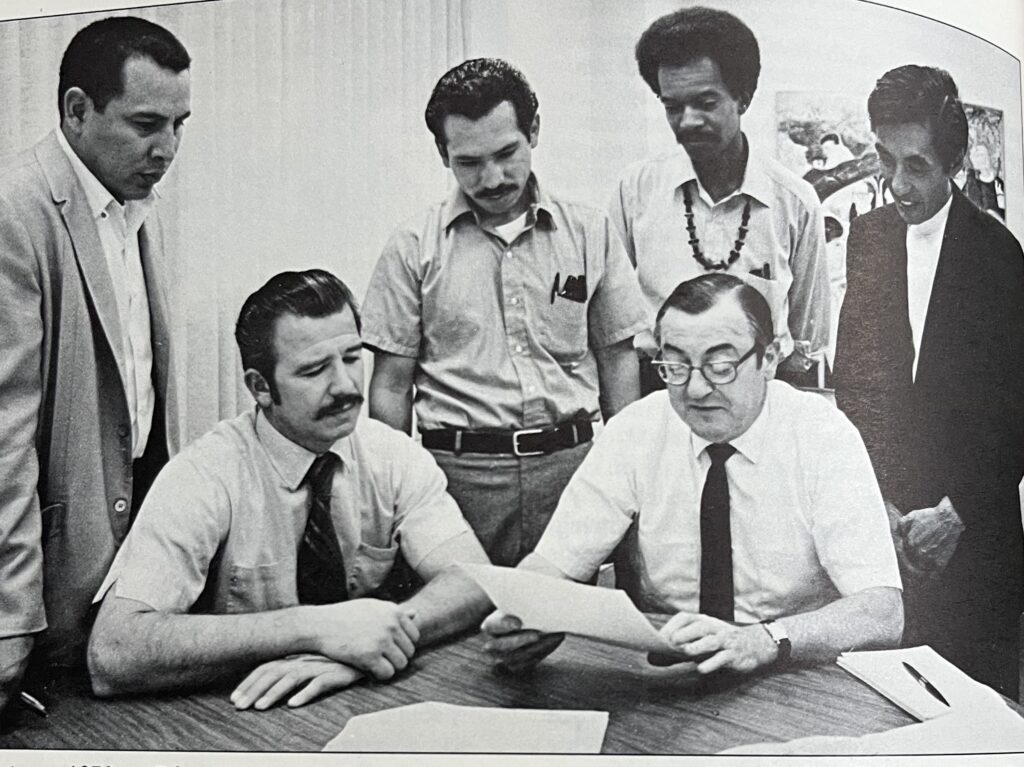
- At the April 9th meeting of the Academic Senate the plans for the Ethnic Studies Department, with eleven faculty positions finalized, was passed just one month after the SFSU program. The department, which originally was called the Ethnic Studies Center, began operations in the Fall of 1969.
- The interdisciplinary program, which would have programs for Pan-African studies, Chicano Studies, Asian American Studies, and Native American Studies, was designed so that students across many majors could be exposed to different cultures and histories, ensuring that minority students would find representation in many classes.
- The program also was heavily involved in the ethnic communities of Sacramento, and encouraged students to directly engage with and empower marginalized communities around the region.
- This included a Native American Halfway House, a “Chicanito” Science program to tutor K-12 kids from underpriviledged schools in STEM, and the Summer Bridge Program to help incoming Sac State freshman from ethnic minority backgrounds become more prepared for college life.
The Lasting Impact of Student and Faculty Activism
The Ethnic Studies Department has continued to promote inclusion, diversity, and social justice across campus and empower minority students by giving them representation at Sac State. Student activism in the 60s was not just at SFSU, Berkley, or other elite institutions across the country, but made an impact right here at Sac State. These student and faculty activists should be remembered and appreciated for making the campus community a more welcoming place for everyone.
If you are interested in the Sac State Ethnic Studies Department visit https://www.csus.edu/college/social-sciences-interdisciplinary-studies/ethnic-studies/
References
- Bloom, Joshua and Waldo E. Martin. The History and Politics of the Black Panther Party. Oakland: University of California Press, 2016. https://www.jstor.org/stable/10.1525/j.ctv1xxsj1.18.
- Bunk, Steve. “Senate Blasts Johns…” The State Hornet, April 11, 1969. California Revealed. https://californiarevealed.org/islandora/object/cavpp%3A84496.
- Burns, Scott. “Sac State: The Silent Sit-In.” The State Hornet, November 20, 1968. California Revealed. https://californiarevealed.org/islandora/object/cavpp%3A84447.
- Burns, Scott. “‘Silent Majority’ Plans Campus Wide Hush-Up.” The State Hornet, November 22, 1968. California Revealed. https://californiarevealed.org/islandora/object/cavpp%3A84448.
- Craft, George S. California State University, Sacramento: The First Forty Years: 1947-1987. Hornet Foundation, 1987.
- “It’s Your Campus. Give A Damn.” The State Hornet, December 6, 1968. California Revealed. https://californiarevealed.org/islandora/object/cavpp%3A84462.
- Hansen, Dean. “Conference on Ethnic Studies…How Long Will Dormancy Last?” The State Hornet, April 8, 1969. California Revealed. https://californiarevealed.org/islandora/object/cavpp%3A84494.
- Jones, Pat. “Crisis Confab: Getting to the Nitty-Gritty.” The State Hornet, December 10, 1968. California Revealed. https://californiarevealed.org/islandora/object/cavpp%3A84463.
- Mitchell, Bill. Letter to the Editor. The State Hornet, November 19, 1968. California Revealed. https://californiarevealed.org/islandora/object/cavpp%3A230602.
- Planning Document. “The Ethnic Studies Center at Sacramento State College.” 14 October 1969. AR 85: Ethnic Studies Center. Gerth Special Collections and University Archives. California State University, Sacramento.
- Ross, Doug. “A Move to Prevent An SF State Here.” The State Hornet, December 3, 1968. California Revealed. https://californiarevealed.org/islandora/object/cavpp%3A84460.
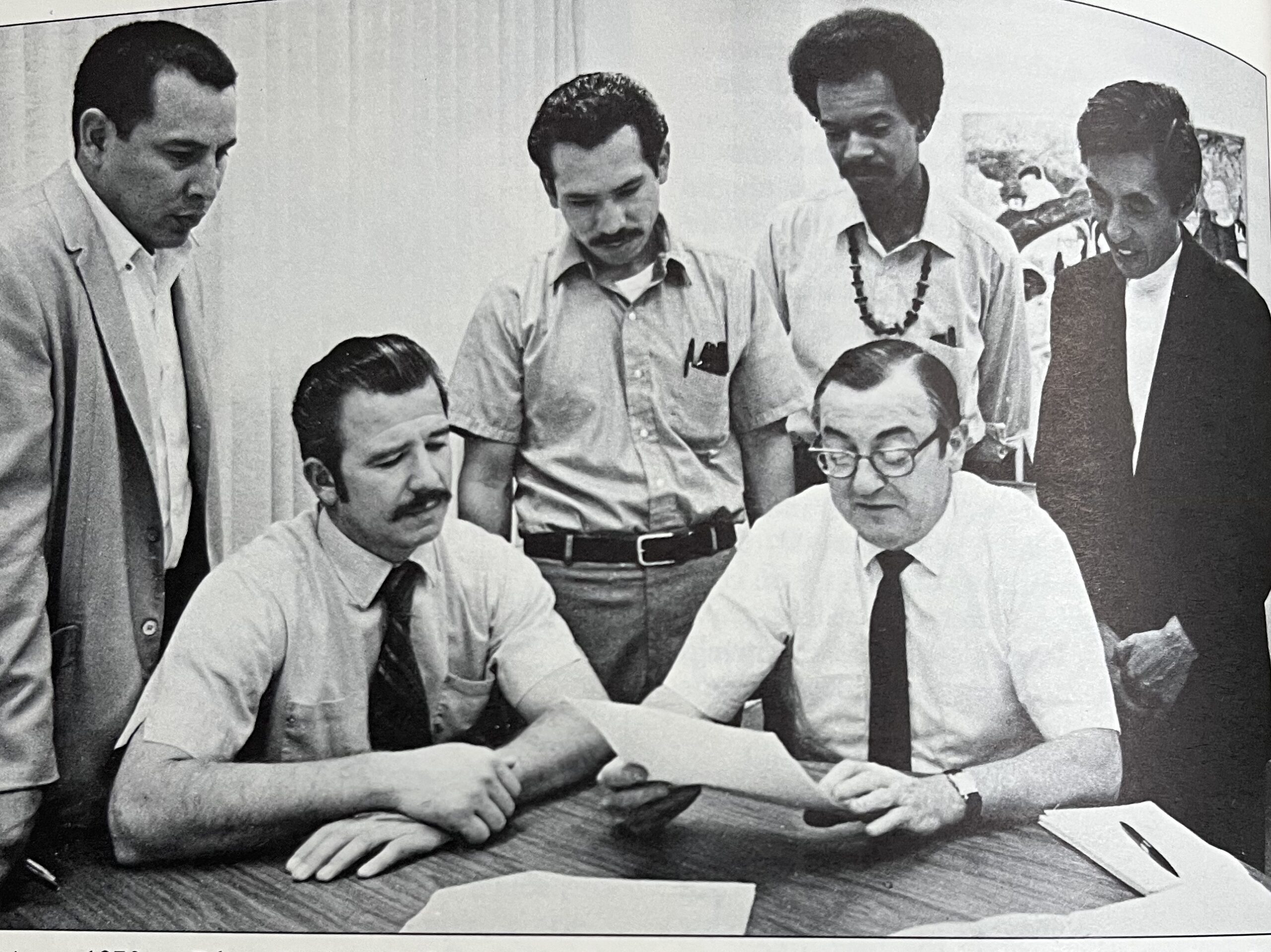
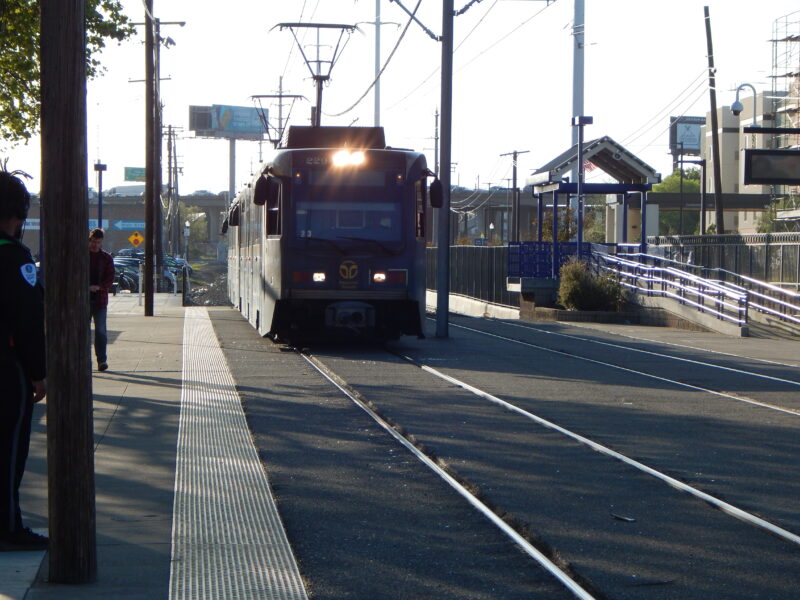
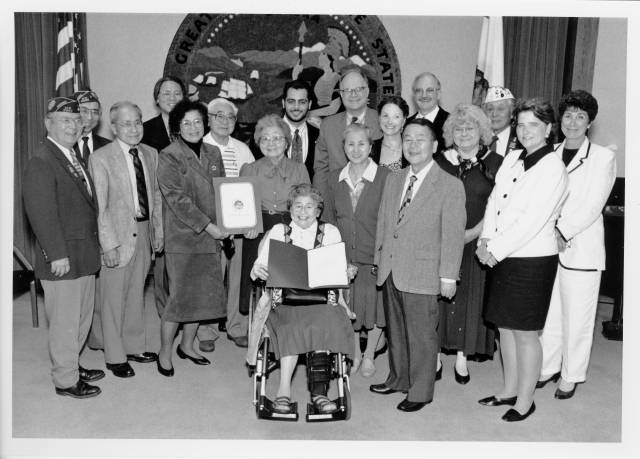
I was surprised to learn there was such an intense history behind the ethnic studies department at Sac State. In my history classes I have read and discussed at length the protests of the Third World Liberation front at SFSU and Cal Berkeley but was unaware there was such a deep overlap with the same protests here at Sacramento State. I thought it was extremely interesting that both the faculty and the students teamed up together to help advocate for the creation of the Ethnic Studies department at Sacramento State. Such a level of cooperation at that isn’t something that’s seen very often today so for so many people at differing levels of authority to agree to amicably cooperate is a very interesting part of Sac State’s History for me. Even with this the strikers still faced opposition from the President and it was likely only through that student-faculty cooperation that they were able to achieve the goals and demands they wanted. Overall it was very interesting to learn that Sac State has a deep history of student activism and that it was active participant in one of the landmark examples of student representation in California and beyond.